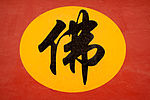
Back Lotussoetra Afrikaans Лотосова сутра Bulgarian সদ্ধর্ম পুণ্ডরীক সূত্র Bengali/Bangla Sutra del Lotus Catalan Lotosová sútra Czech Lotos-Sutra German Sutro de la blanka lotuso de la sublima darmo Esperanto Sutra del loto Spanish Lootossuutra Estonian سوره نیلوفر Persian

| Part of a series on |
| Buddhism |
|---|
 |
| Part of a series on |
| Mahāyāna Buddhism |
|---|
 |
| Chinese Buddhist Canon |
|---|
 |
| Sections |
| Part of a series on |
| Chinese Buddhism |
|---|
 |
| Part of a series on |
| Tibetan Buddhism |
|---|
 |
The Lotus Sūtra (Sanskrit: Saddharma Puṇḍarīka Sūtram, Sūtra on the White Lotus of the True Dharma, Chinese: 妙法蓮華經)[1] is one of the most influential and venerated Buddhist Mahāyāna sūtras. It is the main scripture on which the Tiantai along with its derivative schools, the Japanese Tendai and Nichiren, Korean Cheontae, and Vietnamese Thiên Thai schools of Buddhism were established. It is also influential for other East Asian Buddhist schools, such as Zen. According to the British Buddhologist Paul Williams, "For many Buddhists in East Asia since early times, the Lotus Sūtra contains the final teaching of Shakyamuni Buddha—complete and sufficient for salvation."[2] The American Buddhologist Donald S. Lopez Jr. writes that the Lotus Sūtra "is arguably the most famous of all Buddhist texts," presenting "a radical re-vision of both the Buddhist path and of the person of the Buddha."[3]
Two central teachings of the Lotus Sūtra have been very influential for Mahāyāna Buddhism. The first is the doctrine of the One Vehicle, which says that all Buddhist paths and practices lead to Buddhahood and so they are all actually "skillful means" of reaching Buddhahood. The second is the idea that the lifespan of the Buddha is immeasurable and that therefore, he did not really pass on into final Nirvana (he only appeared to do so as upāya), but is still active teaching the Dharma.[note 1]
- ^ Buswell & Lopez 2014, p. 729.
- ^ Williams 1989, p. 149.
- ^ a b Ganga 2016.
Cite error: There are <ref group=note> tags on this page, but the references will not show without a {{reflist|group=note}} template (see the help page).